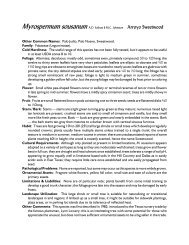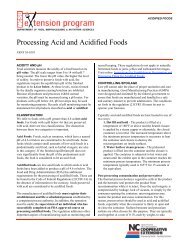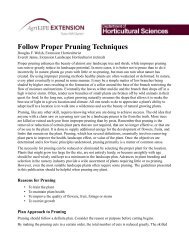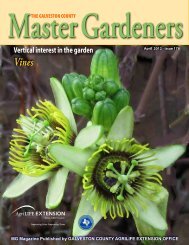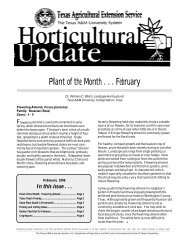Opuntia albicarpa Scheinvar cv. “Reyna” - Aggie Horticulture - Texas ...
Opuntia albicarpa Scheinvar cv. “Reyna” - Aggie Horticulture - Texas ...
Opuntia albicarpa Scheinvar cv. “Reyna” - Aggie Horticulture - Texas ...
You also want an ePaper? Increase the reach of your titles
YUMPU automatically turns print PDFs into web optimized ePapers that Google loves.
INTRODUCTION<br />
Fungi are a group of organisms that has approximately 1.5 million species, of which 72 000 have only been<br />
described; although, every year ca. 1500 new species are registered. Nevertheless, the Fungi Kingdom is one<br />
of the less well-known. Besides the megadiversity of the fungi species, it is important to consider that these<br />
organisms are essential for the human well-being, due to their applications in food production, medical industries,<br />
human health, agriculture, bioremediation, biodeterioration (e.g. plastics) and ecosystem processes,<br />
among other uses. Fungi are also important for the environmental services that they offer to ecosystems. For<br />
example, some saprophytic fungi are in charge of the organic residuals degradation, since they take part in the<br />
organic matter mineralization process. Arbuscular mycorrhizal fungi (AMF), whose phylogeny goes back to<br />
460 million years, are another important functional group for plant community. These AMF are associated with<br />
ca. 90% of living terrestrial plants.<br />
Arbuscular mycorrhizal fungi (AMF) establish mutualistic symbiosis with plant roots forming arbuscular<br />
mycorrhizae (gr. mykes, fungi and rhiza, root) (AM). Both, plant and fungi, symbionts are benefited from the<br />
reciprocal exchange of mineral and organic resources. In exchange for carbon from host plants, these fungi<br />
facilitate plant uptake and transport of soil water and less mobile soil nutrients (such as phosphorus), which<br />
are resources that the plant would difficultly obtain from the soil under stress conditions. AMF are a widespread<br />
component of most terrestrial ecosystems.<br />
Arbuscular mycorrhizae (AM) are characterized for a very small structure resembling a tree; these structures<br />
are located in the plant-root parenchyma cells. These structures, called “arbuscules” are the sites where<br />
the reciprocal exchanges take place. AM fungal hyphae will expand and branch as long as conditions for<br />
growth are adequate to form a mycelium or hyphal network. Through the mycelium, the mycorrhizal plant<br />
explores and exploits the soils to obtain soil water and nutrients. In addition, the mycelium can link the roots of<br />
different plants, where nutrients and carbon can consequently move from one plant to another via root-hyphae<br />
connection.<br />
Arbuscular mycorrhizal fungi (AMF) play a multifunctional role in many diverse aspects of science and<br />
technology, such as plant community dynamics and in plant succession, and in the production of biofertilizers<br />
for agriculture; for instance, AMF are used as inoculums in agricultural and forestry plants, as well as in agriculture<br />
and reforestation programs. AMF facilitate plant nutrient uptake and improve plant-soil water relations for a<br />
wide range of species affecting both productivity and relative abundance of plants, for instance, these fungi<br />
can facilitate plant uptake and transport of less mobile soil nutrients such as phosphorus (they provide until<br />
80% and 25% of the P and N required by the plants), enhance drought tolerance, reduce pathogenic infections<br />
and favors the growth and establishment of plants in disturbed conditions, and ultimately influencing plant species<br />
diversity. In addition, they also have a great effect on soil structure, contributing to improve its aggregation<br />
(e.g. because of the AMF synthesis of the glomalin protein), which favors water and gases fluxes, and nutrients<br />
into the soil, and, at the same time, AMF reduce soil erosion. Therefore, AMF are important to maintain plant<br />
diversity-primary production and for ecological restoration of disturbed ecosystems.<br />
On the other hand, with contributions of molecular biology, mainly the analysis of the mitochondrial DNA,<br />
RNAr subunit, AMF has been grouped in a new Phylum: Glomeromycota, separated from the previous Zygomycota<br />
lineage. In the figure, a recent classification of the AMF (2006) is showed. However, more information is<br />
still required to completely understand the phylogeny of these fungi. In spite of this, the great diversity of the<br />
AMF species has not yet been recorded. Nowadays, only ca. 200 species of AMF has been described. It has<br />
been considered that that the ca. 300 000 plant species diversification took place simultaneously with their<br />
respective fungal associates.<br />
Introduction<br />
7





